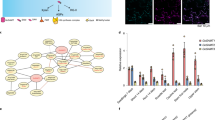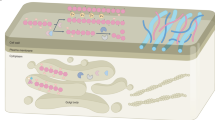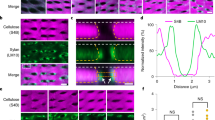Abstract
Xylan and cellulose are abundant polysaccharides in vascular plants and essential for secondary cell wall strength. Acetate or glucuronic acid decorations are exclusively found on even-numbered residues in most of the glucuronoxylan polymer. It has been proposed that this even-specific positioning of the decorations might permit docking of xylan onto the hydrophilic face of a cellulose microfibril1,2,3. Consequently, xylan adopts a flattened ribbon-like twofold screw conformation when bound to cellulose in the cell wall4. Here we show that ESKIMO1/XOAT1/TBL29, a xylan-specific O-acetyltransferase, is necessary for generation of the even pattern of acetyl esters on xylan in Arabidopsis. The reduced acetylation in the esk1 mutant deregulates the position-specific activity of the xylan glucuronosyltransferase GUX1, and so the even pattern of glucuronic acid on the xylan is lost. Solid-state NMR of intact cell walls shows that, without the even-patterned xylan decorations, xylan does not interact normally with cellulose fibrils. We conclude that the even pattern of xylan substitutions seen across vascular plants enables the interaction of xylan with hydrophilic faces of cellulose fibrils, and is essential for development of normal plant secondary cell walls.
This is a preview of subscription content, access via your institution
Access options
Access Nature and 54 other Nature Portfolio journals
Get Nature+, our best-value online-access subscription
$29.99 / 30 days
cancel any time
Subscribe to this journal
Receive 12 digital issues and online access to articles
$119.00 per year
only $9.92 per issue
Buy this article
- Purchase on Springer Link
- Instant access to full article PDF
Prices may be subject to local taxes which are calculated during checkout




Similar content being viewed by others
References
Bromley, J. R. et al. GUX1 and GUX2 glucuronyltransferases decorate distinct domains of glucuronoxylan with different substitution patterns. Plant J. 74, 423–434 (2013).
Busse-Wicher, M. et al. The pattern of xylan acetylation suggests xylan may interact with cellulose microfibrils as a twofold helical screw in the secondary plant cell wall of Arabidopsis thaliana. Plant J. 79, 492–506 (2014).
Busse-Wicher, M. et al. Evolution of xylan substitution patterns in gymnosperms and angiosperms: implications for xylan interaction with cellulose. Plant Physiol. 171, 2418–2431 (2016).
Simmons, T. J. et al. Folding of xylan onto cellulose fibrils in plant cell walls revealed by solid-state NMR. Nat. Commun. 7, 13902 (2016).
Scheller, H. V. & Ulvskov, P. Hemicelluloses. Annu. Rev. Plant Biol. 61, 263–289 (2010).
Kumar, M., Campbell, L. & Turner, S. Secondary cell walls: biosynthesis and manipulation. J. Exp. Bot. 67, 515–531 (2016).
Cosgrove, D. J. & Jarvis, M. C. Comparative structure and biomechanics of plant primary and secondary cell walls. Front. Plant Sci. 3, 204 (2012).
Fernandes, A. N. et al. Nanostructure of cellulose microfibrils in spruce wood. Proc. Natl Acad. Sci. USA 108, E1195–E1203 (2011).
Thomas, L. H. et al. Diffraction evidence for the structure of cellulose microfibrils in bamboo, a model for grass and cereal celluloses.BMC Plant Biol. 15, 153 (2015).
Wang, T. & Hong, M. Solid-state NMR investigations of cellulose structure and interactions with matrix polysaccharides in plant primary cell walls. J. Exp. Bot. 67, 503–514 (2016).
Ebringerová, A. & Heinze, T. Xylan and xylan derivatives—biopolymers with valuable properties, 1. Naturally occurring xylans structures, isolation procedures and properties. Macromol. Rapid Commun. 21, 542–556 (2000).
Nieduszynski, I. A. & Marchessault, R. H. Structure of β-D-(1→4′)-xylan hydrate. Biopolymers 11, 1335–1344 (1972).
Li, L., Pérré, P., Frank, X. & Mazeau, K. A coarse-grain force-field for xylan and its interaction with cellulose. Carbohydr. Polym. 127, 438–450 (2015).
Pereira, C. S., Silveira, R. L., Dupree, P. & Skaf, M. S. Effects of xylan side-chain substitutions on xylan-cellulose interactions and implications for thermal pretreatment of cellulosic biomass. Biomacromolecules 18, 1311–1321 (2017).
Kabel, M. A., De Waard, P., Schols, H. A. & Voragen, A. G. J. Location of O-acetyl substituents in xylo-oligosaccharides obtained from hydrothermally treated Eucalyptus wood. Carbohydr. Res. 338, 69–77 (2003).
Mortimer, J. C. et al. Absence of branches from xylan in Arabidopsis gux mutants reveals potential for simplification of lignocellulosic biomass. Proc. Natl Acad. Sci. USA 107, 17409–17414 (2010).
Oikawa, A. et al. An integrative approach to the identification of Arabidopsis and rice genes involved in xylan and secondary wall development.PLoS ONE 5, e15481 (2010).
Urbanowicz, B. R. et al. 4-O-methylation of glucuronic acid in Arabidopsis glucuronoxylan is catalyzed by a domain of unknown function family 579 protein. Proc. Natl Acad. Sci.USA 109, 14253–14258 (2012).
Rennie, E. A. et al. Three members of the Arabidopsis glycosyltransferase family 8 are xylan glucuronosyltransferases. Plant Physiol. 159, 1408–1417 (2012).
Pawar, P. M.-A., Koutaniemi, S., Tenkanen, M. & Mellerowicz, E. J. Acetylation of woody lignocellulose: significance and regulation. Front. Plant Sci. 4, 118 (2013).
Busse-Wicher, M., Grantham, N. J., Lyczakowski, J. J., Nikolovski, N. & Dupree, P. Xylan decoration patterns and the plant secondary cell wall molecular architecture. Biochem. Soc. Trans. 44, 74–78 (2016).
Chong, S. L. et al. O-Acetylation of glucuronoxylan in Arabidopsis thaliana wild type and its change in xylan biosynthesis mutants. Glycobiology 24, 494–506 (2014).
Koutaniemi, S. et al. Substituent-specific antibody against glucuronoxylan reveals close association of glucuronic acid and acetyl substituents and distinct labeling patterns in tree species. Planta 236, 739–751 (2012).
Manabe, Y. et al. Reduced wall acetylation proteins play vital and distinct roles in cell wall O-acetylation in Arabidopsis. Plant Physiol. 163, 1107–1117 (2013).
Xiong, G., Cheng, K. & Pauly, M. Xylan O-acetylation impacts xylem development and enzymatic recalcitrance as indicated by the Arabidopsis mutant tbl29. Mol. Plant 6, 1373–1375 (2013).
Urbanowicz, B. R., Peña, M. J., Moniz, H. A., Moremen, K. W. & York, W. S. Two Arabidopsis proteins synthesize acetylated xylan in vitro. Plant J. 80, 197–206 (2014).
Bensussan, M. et al. Suppression of dwarf and irregular xylem phenotypes generates low-acetylated biomass lines in Arabidopsis. Plant Physiol. 168, 452–463 (2015).
Xiong, G., Dama, M. & Pauly, M. Glucuronic acid moieties on xylan are functionally equivalent to O-acetyl-substituents. Mol. Plant 8, 1119–1121 (2015).
Vršanská, M., Kolenová, K., Puchart, V. & Biely, P. Mode of action of glycoside hydrolase family 5 glucuronoxylan xylanohydrolase from Erwinia chrysanthemi. FEBS J. 274, 1666–1677 (2007).
Zhang, B. et al. Control of secondary cell wall patterning involves xylan deacetylation by a GDSL esterase. Nat. Plants 3, 17017 (2017).
Das, N. N., Das, S. C. & Mukherjee, A. K. On the ester linkage between lignin and 4-O-methyl-d-glucurono-d-xylan in jute fiber (Corchorus capsularis). Carbohydr. Res. 127, 345–348 (1984).
Lefebvre, V. et al. ESKIMO1 disruption in Arabidopsis alters vascular tissue and impairs water transport. PLoS ONE 6, e16645 (2011).
Kabel, M. A., van den Borne, H., Vincken, J. P., Voragen, A. G. J. & Schols, H. A. Structural differences of xylans affect their interaction with cellulose. Carbohydr. Polym. 69, 94–105 (2007).
Himmel, M. E. Biomass Recalcitrance: Deconstructing the Plant Cell Wall for Bioenergy (Blackwell Publishing Ltd, Oxford, 2009).
Xin, Z. & Browse, J. eskimo1 mutants of Arabidopsis are constitutively freezing-tolerant. Proc. Natl Acad. Sci. USA 95, 7799–7804 (1998).
Li, X. et al. Development and application of a high throughput carbohydrate profiling technique for analyzing plant cell wall polysaccharides and carbohydrate active enzymes. Biotechnol. Biofuels 6, 94 (2013).
Rogowski, A. et al. Glycan complexity dictates microbial resource allocation in the large intestine. Nat. Commun. 6, 7481 (2015).
Gonçalves, V. M. F., Evtuguin, D. V. & Domingues, M. R. M. Structural characterization of the acetylated heteroxylan from the natural hybrid Paulownia elongata/Paulownia fortunei. Carbohydr. Res. 343, 256–266 (2008).
Günl, M., Gille, S. & Pauly, M. OLIgo Mass Profiling (OLIMP) of extracellular polysaccharides. J. Vis. Exp. 40, e2046 (2010).
Enebro, J. & Karlsson, S. Improved matrix-assisted laser desorption/ionisation time-of-flight mass spectrometry of carboxymethyl cellulose. Rapid Commun. Mass Spectrom. 20, 3693–3698 (2006).
Lesage, A., Bardet, M. & Emsley, L. Through-bond carbon-carbon connectivities in disordered solids by NMR. J. Am. Chem. Soc. 121, 10987–10993 (1999).
Fayon, F. et al. Through-space contributions to two-dimensional double-quantum J correlation NMR spectra of magic-angle-spinning solids. J. Chem. Phys. 122, 194313 (2005).
Fung, B. M., Khitrin, A. K. & Ermolaev, K. An improved broadband decoupling sequence for liquid crystals and solids. J. Magn. Reson. 142, 97–101 (2000).
Mortimer, J. C. et al. An unusual xylan in Arabidopsis primary cell walls is synthesised by GUX3, IRX9L, IRX10L and IRX14. Plant J. 83, 413–426 (2015).
Acknowledgements
This work was part supported by the Leverhulme Trust grant for the Centre for Natural Material Innovation. J.W.-R., J.J.L. and O.M.T. are supported by studentships from Conicyt Chile and the Cambridge Trusts, the BBSRC Doctoral Training Partnership BB/J014540/1, and a BBSRC Novozymes iCASE award (BB/M015432/1) respectively. We thank K. B. Krogh for co-supervision of O.M.T. The UK 850 MHz solid-state NMR Facility used in this research was funded by EPSRC and BBSRC (Contract reference PR140003), as well as the University of Warwick including via part funding through Birmingham Science City Advanced Materials Projects 1 and 2 supported by Advantage West Midlands (AWM) and the European Regional Development Fund (ERDF).
Author information
Authors and Affiliations
Contributions
N.J.G. conducted most of the plant molecular genetic and biochemical experiments, assisted by J.W.-R. and M.B.-W. M.D.-T. provided esk1kak genetic material and supporting information. The solid-state NMR experiments were conducted by R.D. assisted by D.I. using plants grown by T.J.S., O.M.T. and J.J.L. Solution NMR was conducted by K.S. and N.J.G. Data analysis was conducted by N.J.G., J.W.-R., O.M.T., J.J.L., K.S., T.J.S., M.B.-W., S.P.B., R.D. and P.D. M.B.-W., S.P.B., R.D. and P.D. supervised aspects of the project. The paper was written by N.J.G., M.B.-W. and P.D. with contributions from all authors.
Corresponding author
Ethics declarations
Competing interests
The authors declare no competing financial interests.
Additional information
Publisher’s note: Springer Nature remains neutral with regard to jurisdictional claims in published maps and institutional affiliations.
Electronic supplementary material
Supplementary Information
Supplementary Figure 1–6
Life Sciences Reporting Summary
Life Sciences Reporting Summary
Rights and permissions
About this article
Cite this article
Grantham, N.J., Wurman-Rodrich, J., Terrett, O.M. et al. An even pattern of xylan substitution is critical for interaction with cellulose in plant cell walls. Nature Plants 3, 859–865 (2017). https://doi.org/10.1038/s41477-017-0030-8
Received:
Accepted:
Published:
Issue Date:
DOI: https://doi.org/10.1038/s41477-017-0030-8
This article is cited by
-
Enzymatic debranching is a key determinant of the xylan-degrading activity of family AA9 lytic polysaccharide monooxygenases
Biotechnology for Biofuels and Bioproducts (2023)
-
Electron tomography unravels new insights into fiber cell wall nanostructure; exploring 3D macromolecular biopolymeric nano-architecture of spruce fiber secondary walls
Scientific Reports (2023)
-
Cellulosic surfaces endowed with chemical reactivity by physical adsorption of functionalized polysaccharides
Cellulose (2023)
-
Patterns in interactions of variably acetylated xylans with hydrophobic cellulose surfaces
Cellulose (2023)
-
Study on Molecular Structure Model and Reactivity of Spent Mushroom Substrate: Experiment and Simulation
Waste and Biomass Valorization (2023)



